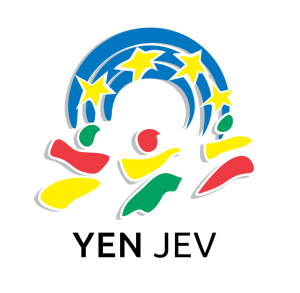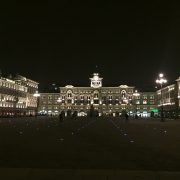The Slovene Minority in Italy
At the official opening of the Kick-Off Seminar in Trst, Italy in February, we were lucky to enjoy the interesting speech of Ksenija Dobrila, a representative of the Slovene minority in Italy. The speech gives a very good picture of the situation of the Slovenes in Italy, thus we share it with you here. Enjoy!

Dear Friends,
Welcome! First of all, I would like to thank the young friends of MOSP for their invitation to the opening of the YEN Seminar. This year’s seminar has a very expressive and striking title: “Training Architects.” Architects, builders of bridges, creators of relations between nations, weavers of Intercultural Dialogue, a fundamental value of the European Union. It seems to me that the contents of the seminar itself are extremely appropriate and topical: in fact, they focus on the competences of successful leadership. There is much need of the latter in a minority, as well as in the general social environment: the need for educated young people, who would assume responsibility for decision-making, motivational management, effective communication, and who have a basic understanding of social managment. We all share a common feature: we belong to a minority reality. A feature that is common to a community of about 40 million EU citizens who belong to linguistic minorities. This means that in the field of diversity management you have developed a special skill from the cradle onwards: understanding the cultural contacts and developing a sensitivity to the intermingling of cultures. I am sure that you will be able to use your newly acquired skills successfully in your own fields, and that you will bring new content to the intercultural dialogue, full of enthusiasm, and with the shine that is typical of young people. Intercultural dialogue is a very complex concept, which basically encompasses the understanding and reflection about diversity, and acceptance of diversity, that aims at cooperation and creative coexistence. This is the challenge of modern times both for the individual and for society.

We, the Slovenes in Italy, are a historic minority community, arisen as a result of historical processes that have influenced the redefinition of borders. Culturally, linguistically and ethnically we are connected with the Slovenian people in the neighboring country. We are a minority of a small nation in the heart of Europe, at the intersection of three major European ethnical groups: the Germanic, the Romanic and the Slavic. But the lifeblood and joy of a small nation is best exemplified by the inspiring words dedicated to the Slovenes in the middle of the 16th century by Primož Trubar, the father of Slovenian literature: stand and withstand. In this area, States, political regulations and boundaries have changed over the centuries, but our language and culture have remained. We are a nation of poets, writers, musicians, and artists. Our identity has been shaped through cultural creation rather than through mighty battles or conquests. Culture has raised our national awareness and has preserved us through the centuries, even in very difficult times, when our nation was on the verge of nullification.
Being proud of their roots and their identity throughout the centuries has given sense to the existence of the Slovenian minority, which settled before the year 600 in the territory that is now incorporated in the Italian state and encompasses 32 municipalities along the eastern border of the Region Friuli Venezia Giulia. The Slovenes in Trieste and Gorizia have achieved their greatest economic and cultural thriving at the turn of the 19th into the 20th century. In the first half of the 20th century, relations between the two indigenous communities in this area – the Italian majority and the Slovenian minority – became tense, especially so with the onset of the fascist authorities. That period saw the beginning of the worst denationalization policy against Slovenes with fatal consequences: Slovenian schools were closed down, public use of the Slovenian language was banned, names and surnames were changed into an Italian form, place names of Slovenian origin were renamed, Slovenian libraries, cultural centers, theatres, and newspapers were closed and burned down, Slovenian economic institutions were abolished, families were displaced and deported. We witnessed a proper ethnic cleansing that lasted until the end of the Second World War and that severely weakened the Slovenian national group. The Slovenian minority struggled to resist the denationalization with all its strength and was actively involved in the resistance movement. In the post-war period, the Slovenian community restored and re-developed its educational, cultural, economic, sporting structure. In that period, a process of slow normalization of relations between the Slovenian minority and the Italian majority began. But the post-war decades in this area were also a period of high tension: in Italy, there was no catharsis and atonement following fascism and nationalism and the socio-political events of World War II. A centralized state administration is still the prevailing model in Italy. This model is oriented towards processes of identification, integration and uniformization within the Italian nation itself, and does not support its multilingual resources; consequently, it is less sensitive to the themes of diversity and minority issues. In any case, in the mid-nineties of the last century, there was growing political attention to the ethnic, national and linguistic minorities in Italy. This was mainly due to the intensity of strategies and mechanisms that were being developed in the EU on the issue of diversity management and protection of minorities. At the turn of the 21st century, Italy introduced the legal framework for minority protection, which allows the management, preservation and development of ethnic and linguistic minorities, with two important laws. These finally fulfill the constitutional ordinance expressed in Article 6, which ties the State to specific legal obligations in order to protect linguistic minorities. The Protective law for Slovenes in Italy (2001) guarantees cultural autonomy, which is primarily focused on the right to use Slovenian in public administration and in the areas where Slovenes live, i.e. the so-called visible bilingualism in toponyms, signposts, public signs; it guarantees an educational system in Slovenian, and autonomy of the organizational structure of the minority. Anyway, more than a decade passed between the approval of the law to its implementation.
After a two-year chairmanship of the Institutional Parity Committee, the body that monitors the implementation of the Protective law for Slovenes in Italy, I noticed what each member of the ethnic community feels: bilingualism in public administration is being implemented very slowly. The same is true for actual visible bilingualism, although there have been some good practices and some administrations are gradually accepting the new norms. Protecting the Slovene language of the minority demands a constant state of alert, it requires persuasion, negotiation, warning at all levels – from the ordinary official to the Government. All too often we face rigid bureaucratic dullness, and sometimes there is even something else behind it: centralizing forces that think that citizenship means national uniformity. However, the Protective law brought about a refreshment in interethnic relations in our region, which have been crucially influenced by the epochal geopolitical and social changes in the last twenty-five years – since the fall of the Berlin Wall.
Ever since Slovenia joined the EU and the borders were abolished, the interethnic relations have normalized, assimilation tendencies have loosened up, the latest generations have lived in a more relaxed coexistence, the position of the Slovenian language has changed. Slovenian, deemed over the centuries by Italian nationalists as a subordinate language for proletarians, maids, farmers, laborers, has finally arisen to its rightful status in the area that had been permeated and culturally co-created by it.
A fact that can not be overlooked is that we live in an area that has had one of the lowest birth rates for a long time; we have been hit by the severe economic crisis with consequent unemployment, especially among first-time jobseekers, which has led to an exodus of young people, mostly highly educated. Furthermore, there is an increased desire of the younger generations, the millennials, who have grown up in the spirit of Europeanism, integration, multilingualism, and mobility, to follow the impulses that lead them into the wide world. If the erosion of national bodies is quite alarming in large European nations, it is obviously all the more so for the Slovenian minority, which is an external branch of an already small nation. Its erosion might well be a threat to its very existence. We have noticed that the ethnic picture in our schools has changed considerably in recent years. As the desire to get to know the Slovenian language increased in the area, there has been an increase in the number of children in Slovenian schools. Research studies show that the long-term existence and development of our national community is only possible if we will be able to attract new members and integrate them into our reality.
What I am talking about is a strategy of acquiring new speakers of Slovenian language. In the first place, this must be done by our schools, which not only accept in their ranks Slovenian and bilingual children, but also children from Italian families. In many cases, this is also the consequence of a dissimilation phenomenon, or return to the original ethnic roots. The Slovenian national community must therefore develop a programme of language policy, and at the same time effectively direct the new social integration aspirations of young people at the local level, making Slovenian a second native language, which is also the language of the neighbour. Such language can expand the potential of social relations, the area of residence and job opportunities, offers additional possibilities to benefit from cultural life and social relations. However, when setting language strategies, we need to be very clear and principled. We must point out unequivocally that the Slovenian schools are originally and by law intended for the education of Slovenes in Italy, that the main curricular, programmatic and conversational language is Slovenian, and that their role, in addition to education, is to transmit and consolidate the Slovenian ethnicity.
In these changed social and political circumstances, our national community has undoubtedly strengthened the role of the various factors that shape, together with the Friulian and German communities, the cultural diversity and autonomy of the Region Friuli Venezia Giulia. But we must face many other endeavours in the management of linguistic diversity in our Region.
They don’t frighten us. We will confront them and try to solve them, and this will never stop our intercultural dialogue. We seek ways that unite us, and not divide. Our minority has a genetically inherent vitality, which is evident in the diverse associative, theatrical, musical, sports activities, and many of our staff have reached international recognition. We have had Slovenian schooling for seven decades since its re-establishment, from nursery schools to senior secondary schools, with thousands of graduates who have preserved and consolidated the Slovenian national body. We move confidently on both sides of the border, we master several languages, we know different social systems, and we have developed a more vigorous critical thought. The advantage of experiencing two cultures together has enriched our experiences, has made our thought more adaptable and flexible, has expanded our conceptual world, our empathic ability to sense and accept diversity.
To all of you, young members of the European national minorities, a similar experience represents an advantage and added value. It’s your time – with your competent knowledge, youthful energy, creativity, and awareness, you shall manage both your minority dynamics and the wider area of our common homeland Europe. Bring new life, originality, technological knowledge and the freshness of penetrating, emphatic thoughts into this domineering gerontological society.
I wish you to gain much new knowledge at this seminar, to return to your homes with great satisfaction and with a precious memory of our own homeland.”


